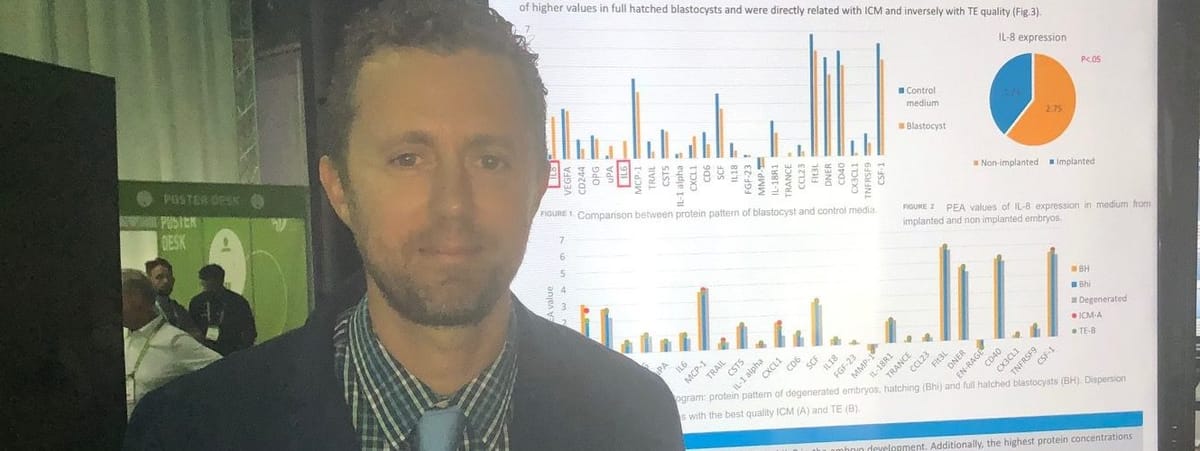
New research conducted by IVI has revealed important new discoveries in the field of embryo selection as part of the IVF process. This is highly significant because improved embryo selection is key to IVF success rates and can therefore help more people in their ambition build their families. These exciting advances were presented to a gathering of the foremost professionals in the field of reproductive technology at the 2019 annual meeting of the European Society of Human Reproduction and Embryology (ESHRE), which took place in Vienna.
In this article we provide some context on the research discoveries, which make use of artificial intelligence to refine results, plus information on the background of IVI and its contribution to advancements in the field of assisted reproduction. We also look at a summary of how In Vitro Fertilisation (IVF) works and why these developments can have a far-reaching impact on the future of assisted reproduction.
How does the research impact on IVF success rates?
The research was presented at the 35th annual meeting of ESHRE; this body is the major conference on Assisted Reproduction in Europe. It is well established as the focal point where professionals from all corners of the globe gather together every year in order to share knowledge and experience, present research findings and arrive at significant resolutions that pave the way to the future of assisted reproduction. IVI presented two aspects of its research on embryo selection, the first concerning measuring the protein profile produced by single embryos, the second relating to the measurements of free radical production by groups of embryos.
Measurement of embryo-produced protein profile
Dr. Marcos Meseguer presented results of the first study which looked at the “protein profile of euploid single embryo transfer”. In simple terms, this means analysing the proteins secreted by a single embryo into the culture medium. ‘Euploid’ simply means having the correct number of chromosomes (46 for humans) and the significance of this is that the work was carried out on embryos which had already been selected as being free from genetic abnormalities. It was already known by medical personnel that, in spite of being theoretically genetically viable, not all embryos succeed in implanting. The mission was to find any differences that could help distinguish those with more potential for implantation and therefore improved IVF success rates and a higher probability of a successful pregnancy.
The team found that there were different patterns of protein concentrations among the different embryos studied. They confirmed that there was a significantly higher secretion of the proteins IL-6 and IL-8 in growing embryos, and that those which presented a pattern of higher values were most likely to implant successfully.
Production of free radicals as a biomarker of good quality embryos
The second study focused on analysing the oxidative profile of the culture media in which groups of embryos were developing. This involved groups of 10–12 embryos contained in a single drop of culture medium. The team developed a method for assessing a multiple-embryo environment which produces differences in oxidisation that are high enough to be measurable.
They found that in groups with more active and better-quality embryos, more oxidation was measured in the culture. These higher levels indicate that they are better prepared for transfer and subsequent implantation, meaning a higher success rate for patients. By the same token, the groups with lower levels of oxidisation corresponded with a reduction in the quality of the embryos.
Artificial intelligence: the future of improved IVF success rates
Both studies made use of new technologies in Artificial Intelligence (AI) to achieve their improved embryo selection. It has become clear that some level of automation, including the use of AI in selecting embryos or carrying out genetic testing, represents a real step forward in achieving improved results
How does IVF work and why are these results so important?
When you take the results of these studies into the context of the IVF process, its significance becomes very clear. At the heart of the process is the ability to select the healthiest and most viable embryos for implantation to lead to a successful pregnancy. But where does the selection of the best embryos fit into the whole picture? To understand this, we need an outline of the various stages of the IVF process and how it works. You can also access the IVI video about IVF on our YouTube channel to see a summary. In a nutshell, these are the steps:
- Ovarian stimulation is the first step, when medication is used to stimulate the ovaries into producing a larger number of oocytes than the usual one ovum per month.
- Collection of the oocytes comes next, in a process known as follicular puncture. This takes place after confirmation that the oocytes have matured in the same way they would in a natural cycle.
- Fertilisation of the oocytes follows, using a sperm sample from the male partner or donor. This takes place either by the conventional IVF method of mixing oocyte and sperm in a culture plate, or through ICSI, which involves direct injection of a selected sperm into the ovum.
- The resulting embryos are then observed under laboratory conditions for a number of days and are selected according to their morphology and potential for viability. This is the point when improved selection, the application of artificial intelligence and the knowledge and skill of experienced medical practitioners are all so central to success.
- Finally, the selected embryo is transferred into the patient’s uterus. We then wait for confirmation of whether implantation has taken place, and whether the IVF process has resulted in a successful pregnancy.
Learn more about IVI
If you would like to know more about our record of successful IVF treatments, you can browse our website and check our audited clinical results for yourself. You will see that our record of success is already very good and, as a result of this latest research, looks set to improve even further. If you would like to get in touch, you can phone us or use our online contact form and an adviser will contact you.





Comments are closed here.